Checking out the local waterfalls is one of the best things to do in Victoria, and it’s incredibly easy to do so. Not only are there a handful of gorgeous waterfalls near Victoria, they’re all supremely accessible, even to the least hiking-inclined visitor. Almost all take less than half an hour to get to, and several are basically located right off of the road.
Vancouver Island is home to ancient forest giants residing in some of the world’s last surviving pockets of temperate rainforest, as well as spectacular waterfalls, high mountain peaks, and more caves than the rest of Canada combined. It really is an outdoor adventure lover’s paradise. So it confused me that most Victoria locals I’d talked to have only travelled up to the wilder and more remote parts of the island once or twice, and many not at all. The explanation is simple of course – when you’re living in BC’s capital you don’t have to travel far for beautiful nature experiences. Most Victoria residents are used to driving only a short distance out of the city to get some truly awesome views, so driving even further is a hard sell.
Continue reading this blog post for everything you need to know to experience these 10 incredible Victoria waterfalls for yourself, including distance, elevation gain, how to get there, the best time to visit, and lots of photos of my experience.
Not located in Victoria? check out my list of awesome waterfalls near Nanaimo!
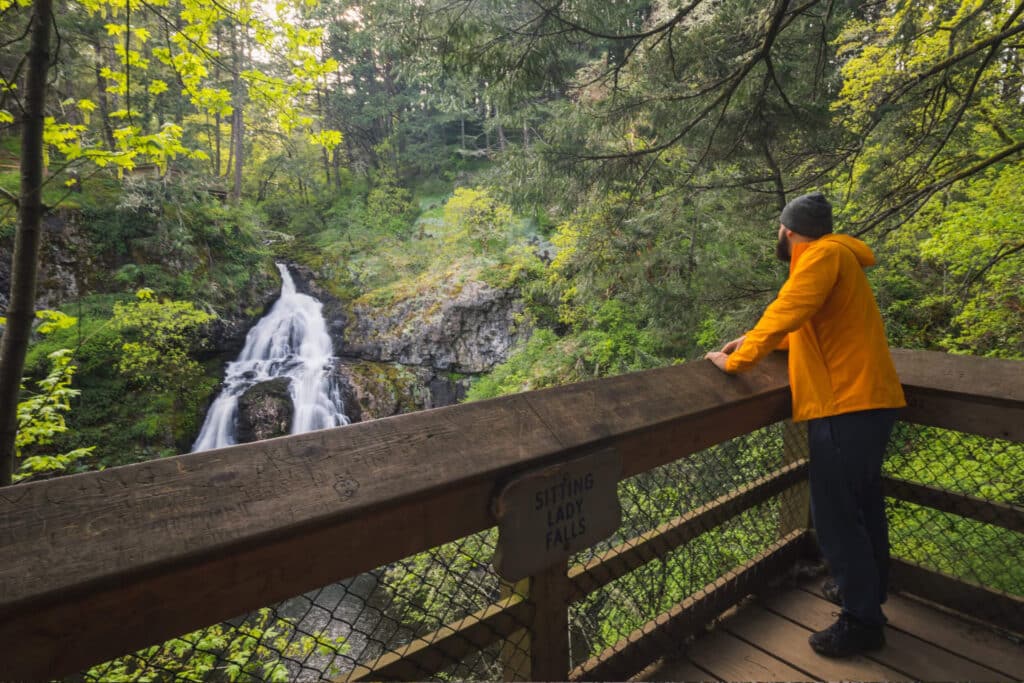
Tips for Visiting Victoria Waterfalls
When in the outdoors it’s important to avoid harmful practices such as disturbing plants or rock-stacking, or removing any natural object from flowers to rocks, as it’s important to leave the environment as natural as possible for the animals and for fellow hikers to enjoy in perpetuity. As many flowers as there are, there are few enough that if we all took one, then there wouldn’t be any left. Take only photos, leave only footprints.
I also highly recommend reading up on Leave No Trace principles before heading anywhere into the outdoors in general. Following these important principles basically means doing your best to leave beautiful places like these Victoria waterfalls as good (if not better) than you found them, both for their preservation and for the enjoyment of other visitors.
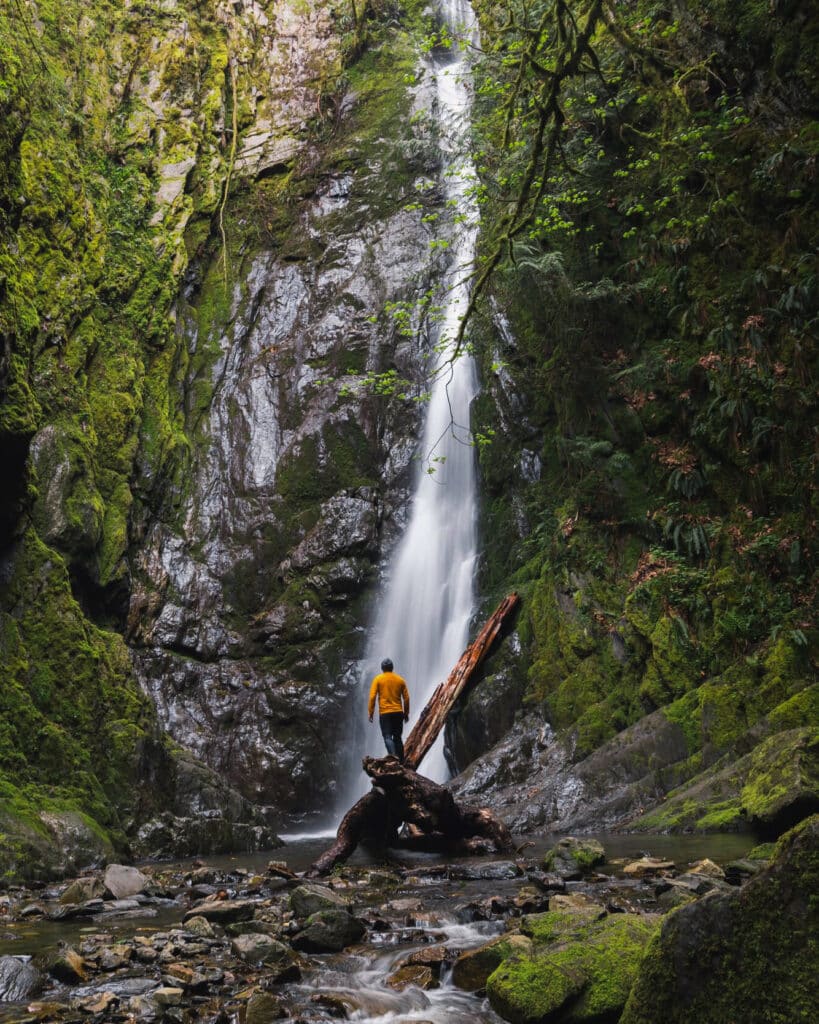
When to Visit Waterfalls Near Victoria
Most waterfalls on Vancouver Island are primarily fed by rainwater, fortunately for local waterfall chasers Victoria is located in one one of the rainiest and wettest regions in all of Canada. During the months of winter when the rest of Canada is blanketed in snow, Victoria rains and rains and rains. For this reason winter and early spring are the best seasons to visit waterfalls in the region. Visitors to Victoria in the summer can expect to find many of the waterfalls listed here significantly diminished, with many waterfalls drying up almost completely during the drier summer and early autumn months.
Best Victoria Waterfalls
Sitting Lady Falls
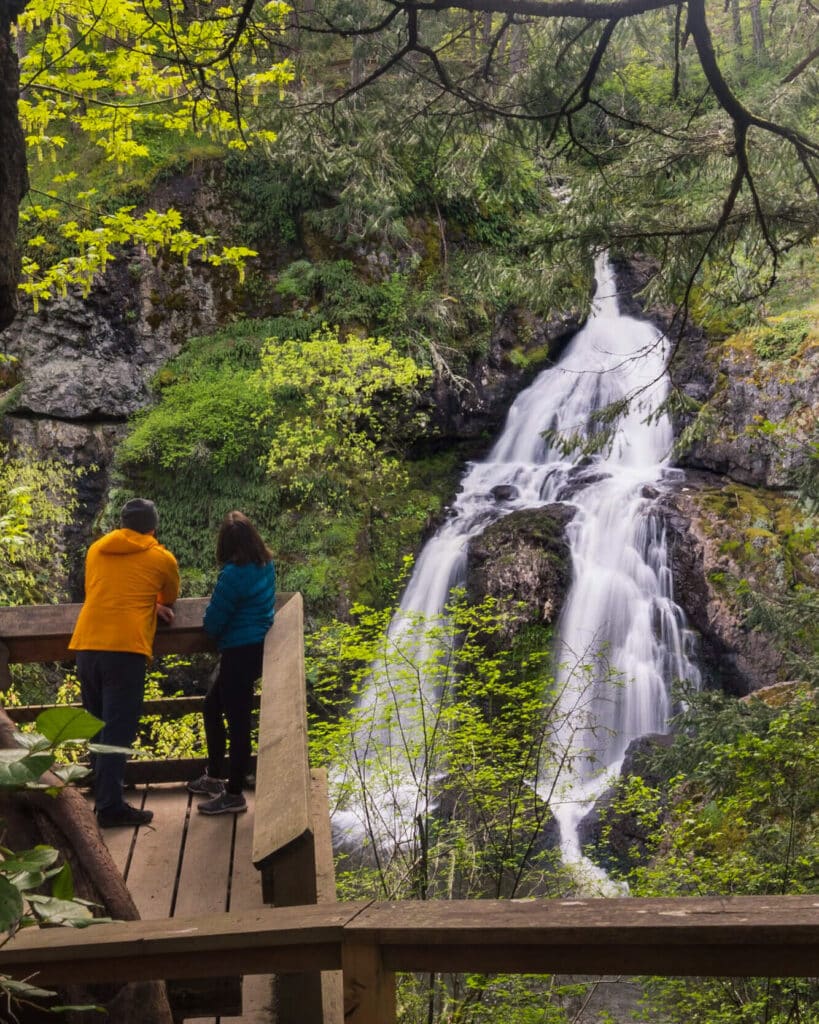
Distance from Downtown Victoria: 21 km
Walking Time: 40 mins
Sitting Lady Falls is located at Witty’s Lagoon, a bird-watcher’s paradise near Metchosin southwest of Victoria. Here it’s possible to take a two-minute stroll to this stunning Victoria waterfall, or to park a little further away and enjoy an even more pleasant walk along the lagoon, keeping an eye out for any of the 160 species of birds that can be found in the park. Whichever route you choose, the waterfall at the end is one of the best waterfalls Victoria has to offer.

Mary Vine Creek Falls
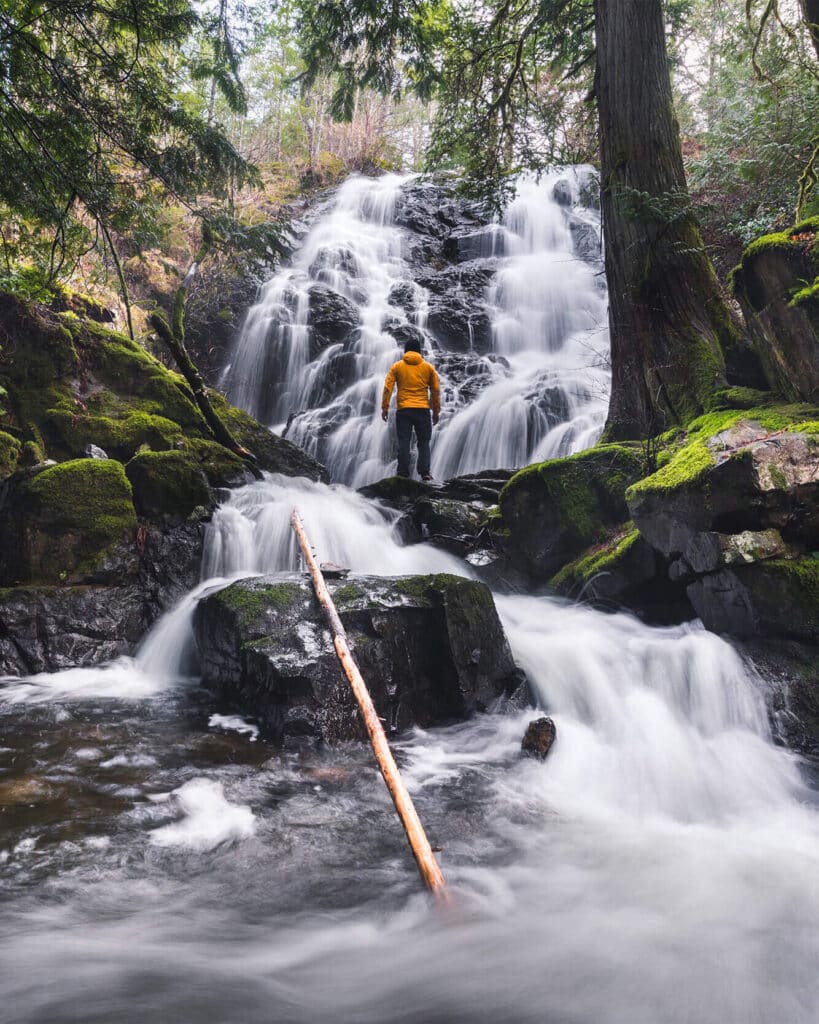
Distance from Downtown Victoria: 43 km
Walking Time: 45 mins
Mary Vine Creek Falls is the furthest waterfall from Victoria on this list, though it’s still a popular spot among Victorians. Access is from Sooke Potholes Provincial Park at the end of a drive through some gorgeous old forest. A short pleasant walk up alongside Mary Vine Creek leads through the woods to this beautiful waterfall popular among local photographers.
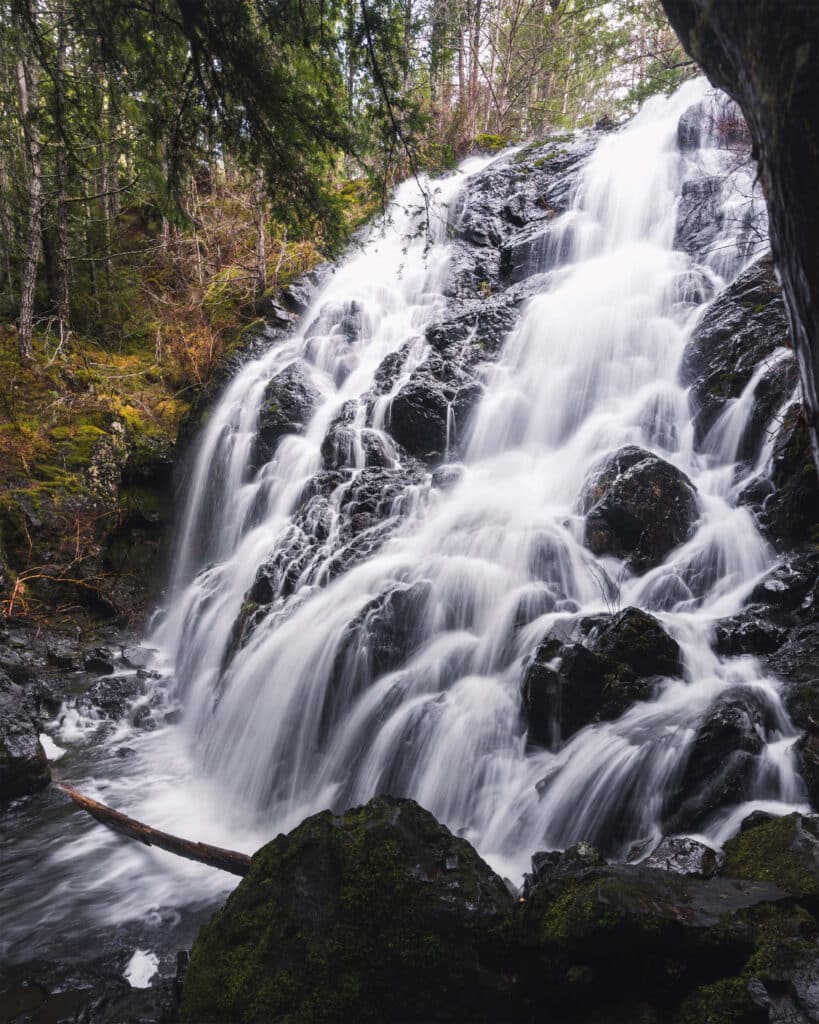
Todd Creek Falls
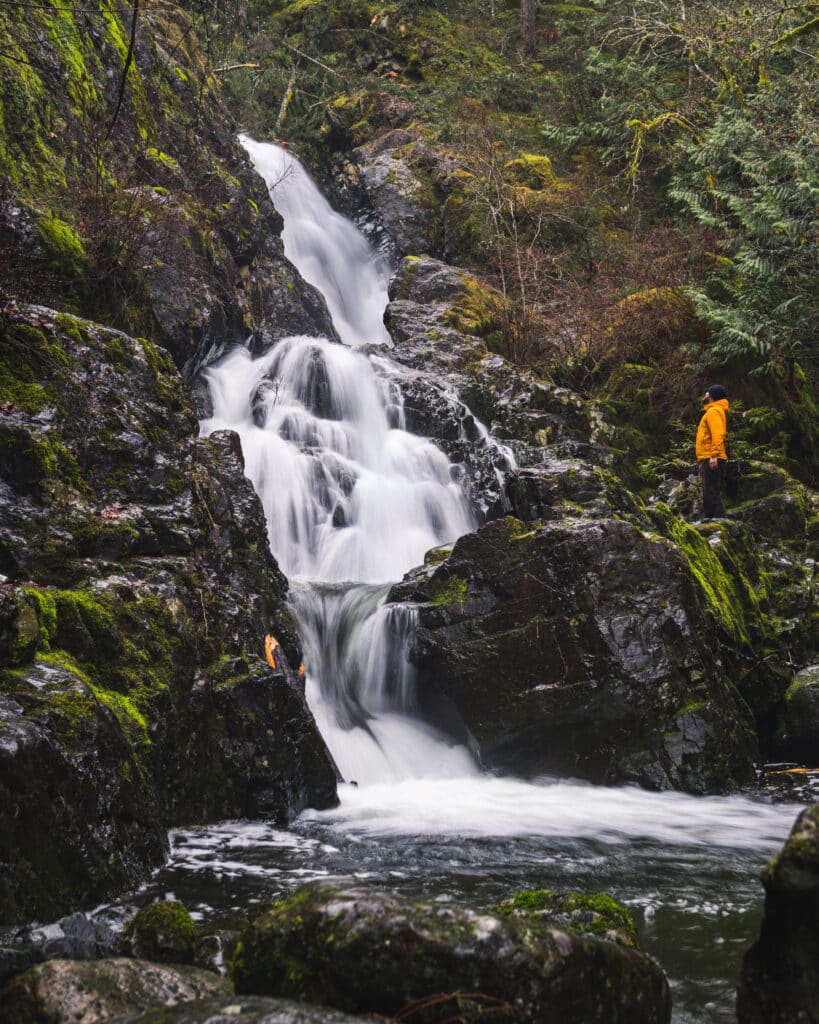
Distance from Downtown Victoria: 42 km
Walking Time: 5 Mins
Todd Creek Falls is another fantastic Victoria waterfall that’s often visited in conjunction with Mary Vine Creek Falls, as both are accessible from the same park. Todd Creek Falls is visible from the road on the drive to the Mary Vince Creek Falls parking lot, but the best views are obtained by parking in the nearby lot and walking up to the falls themselves. If you’re driving to visit one of these waterfalls, I highly recommend visiting the other as well.
Niagara Falls

Distance from Downtown Victoria: 20 km
Walking Time: 15 mins
Niagara Falls in Goldstream Provincial Park is probably the best-known of all of Victoria’s waterfalls, and that’s not only due to confusion between this and the much more popular Niagara Falls in Ontario. This spectacular Victoria waterfall is tucked in at the end of a gorgeous mossy canyon only a short distance from the highway. Fortunately the crashing of this fantastic waterfall drowns out any sound of passing highway traffic, making the spot a perfect nature oasis not far from the development of the city.
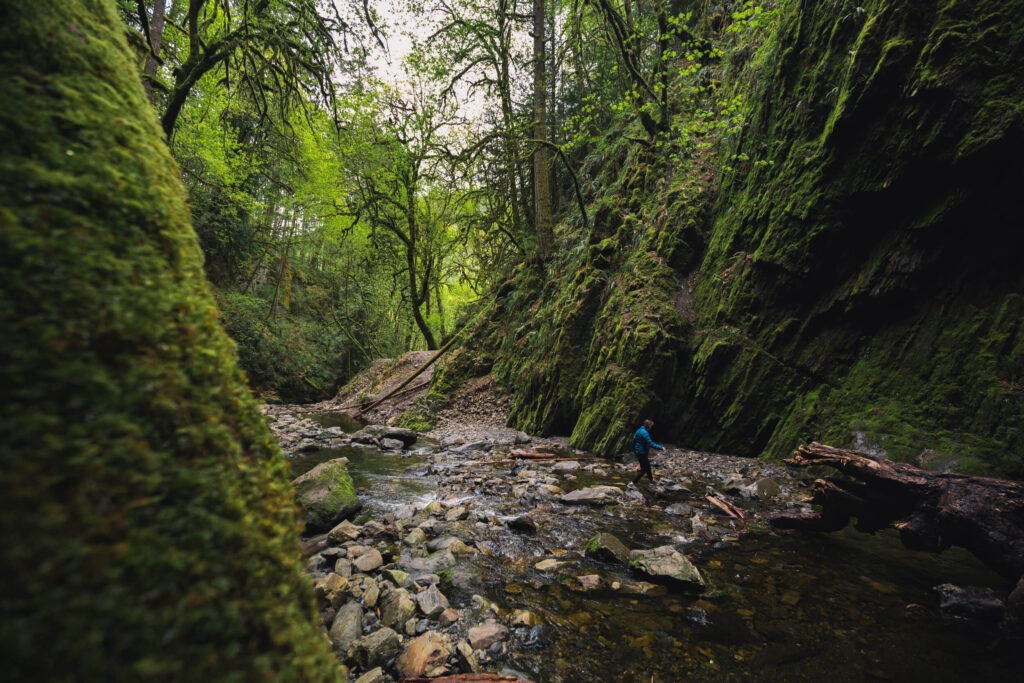
Goldstream Falls
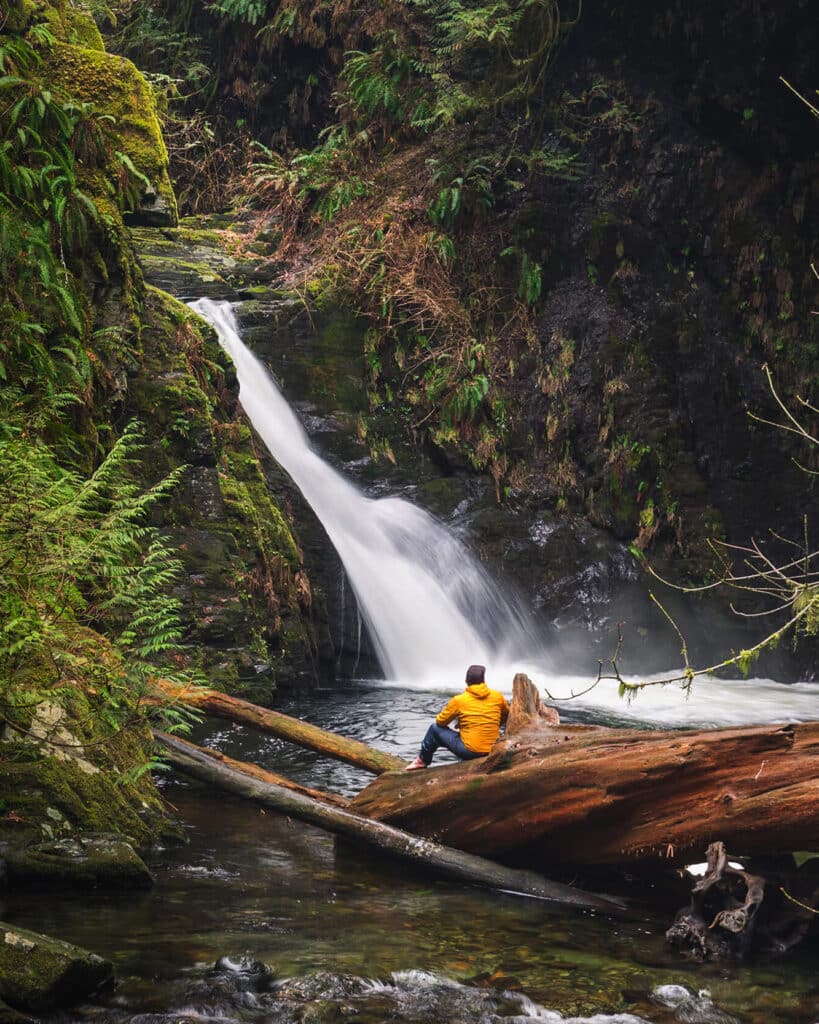
Distance from Downtown Victoria: 18 km
Walking Time: 1 Hr
Goldstream Falls is one of the most deceptively impressive waterfalls near Victoria, with photos completely failing to capture its size and strength. Goldstream Falls crashes into a large deep pool that in the summer is a popular swimming spot. This pool also prevents anyone with a camera from getting too close to the falls, making it look much smaller in photos than it is in reality. The walk to this spectacular waterfall in Goldstream Provincial Park starts from the Goldstream Campground and heads up alongside Goldstream River. The walk does involve a surprising amount of elevation gain as it leads to the waterfall, but the lush moss-covered ancient trees along the way more than make up for the work that’s required to visit this waterfall.
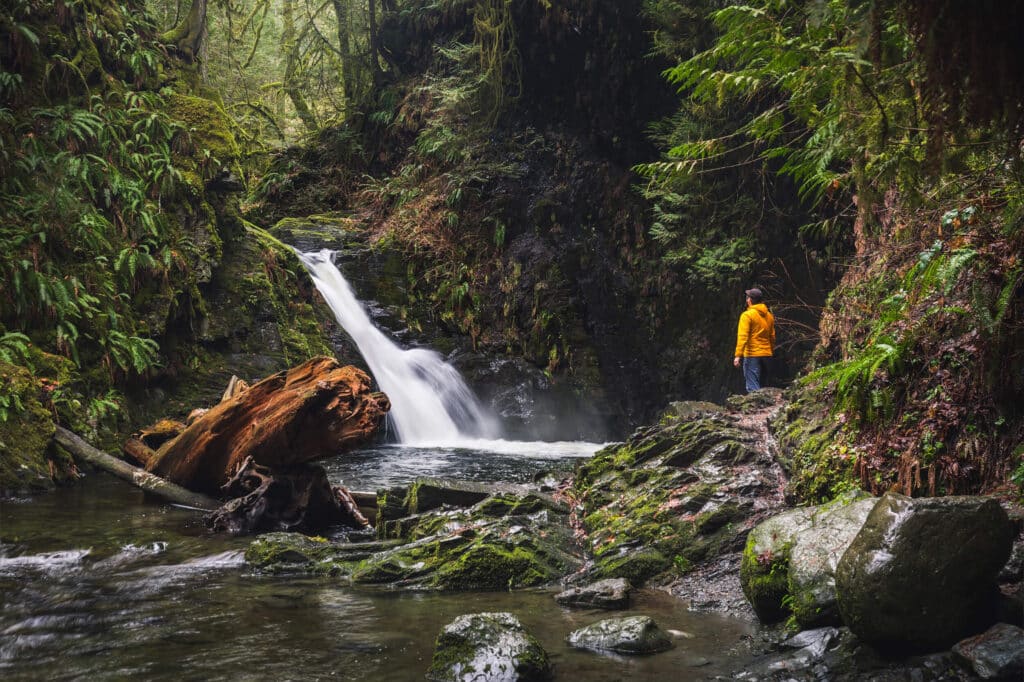
MacFarlane Falls
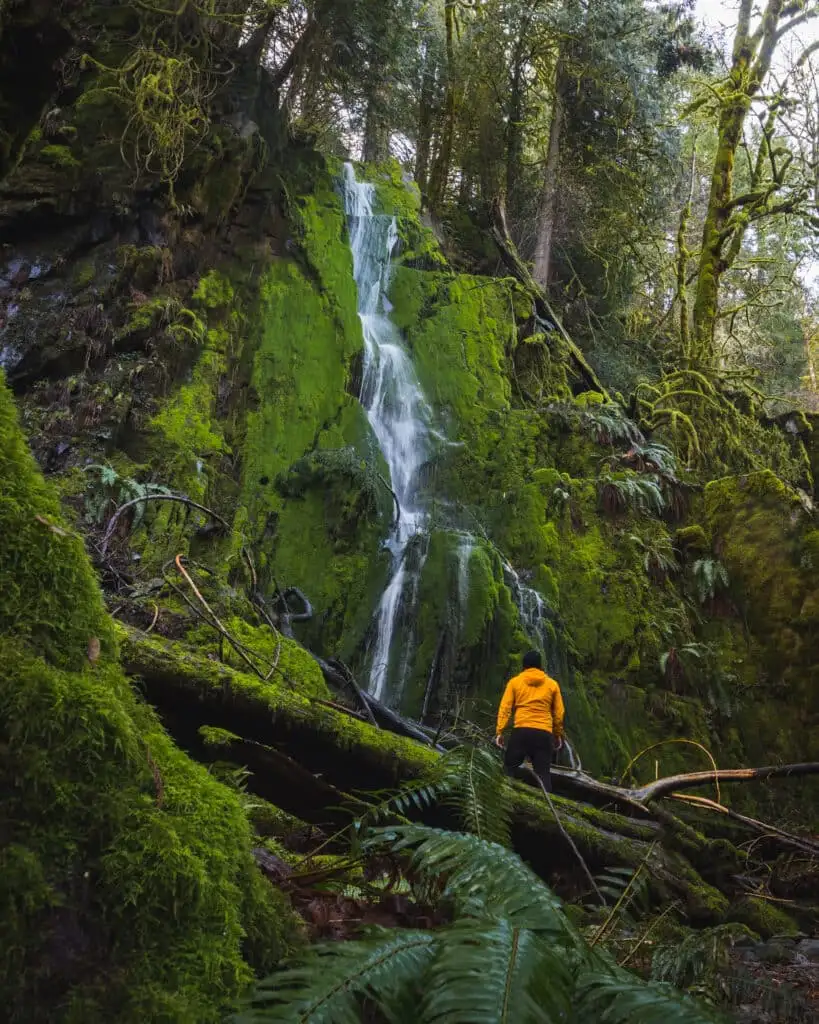
Distance from Downtown Victoria: 19 km
Walking Time: 10 mins
MacFarlane Falls is a unique seasonal waterfall found in Goldstream Provincial Park, only appearing in the winter and requiring significant rainfall to get really spectacular. While some people dismiss seasonal waterfalls as not real waterfalls, the vast majority of waterfalls on Vancouver Island are fed mostly by rainwater and dry up in the summer, so the distinction between “real” waterfalls and ones fed only by rainfall seems pointless. The short walk to this lovely Victoria waterfall crosses the Goldstream River and leads past some truly magnificent trees. Even if the waterfall isn’t flowing particularly strongly, the mossy primeval forest environment is a delight.
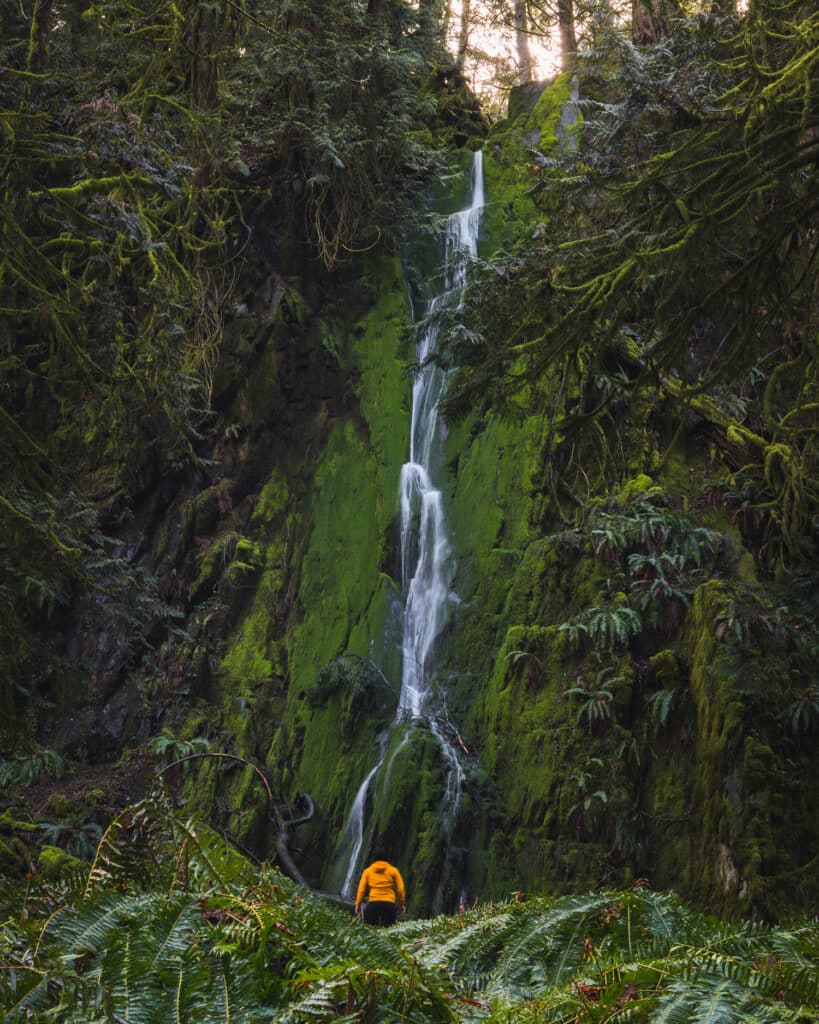
Hidden Spring Falls
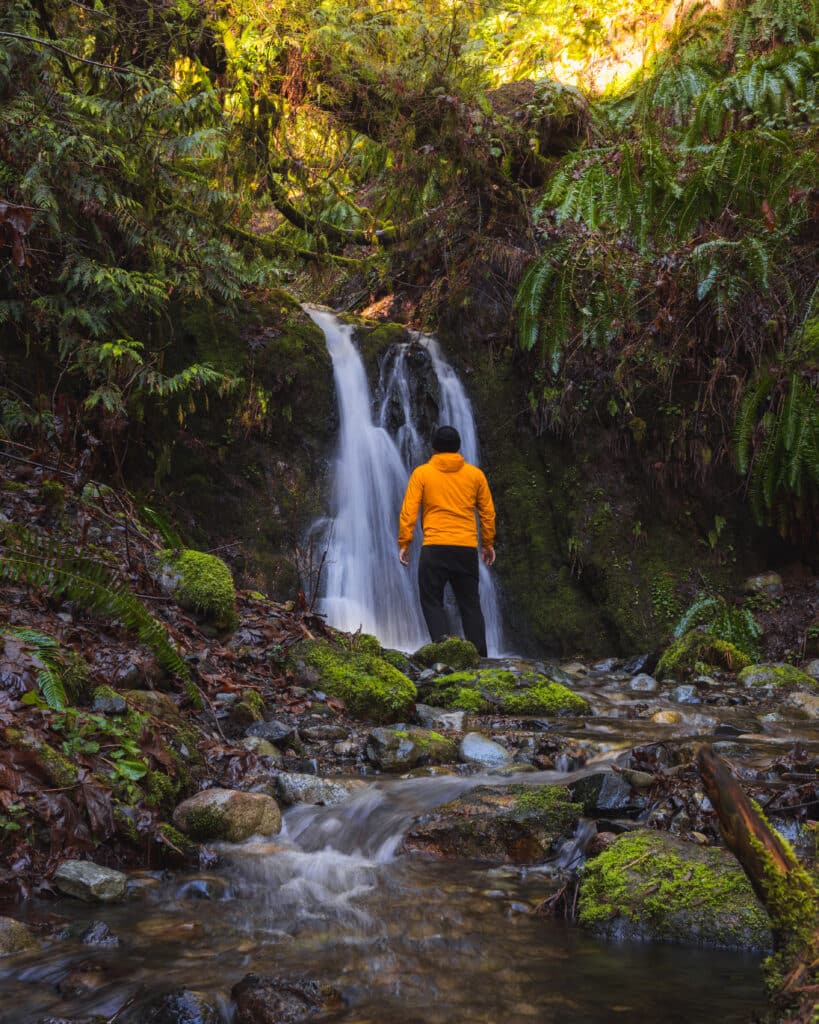
Distance from Downtown Victoria: 18 km
Walking Time: 15 mins
Despite being the smallest waterfall near Victoria, I was really surprised to find it ranking as one of my favourites. Like the other waterfalls in Goldstream Provincial Park, Hidden Spring Falls is accessed by a short walk from the highway. Much less visited than the park’s two most well-known attractions Niagara Falls and Goldstream Falls, Hidden Spring Falls offers a quiet little forest sanctuary where you’re unlikely to see anyone else. The trail is marked on official maps, but doesn’t seem to be maintained or promoted to the same degree as the other waterfalls in the park.
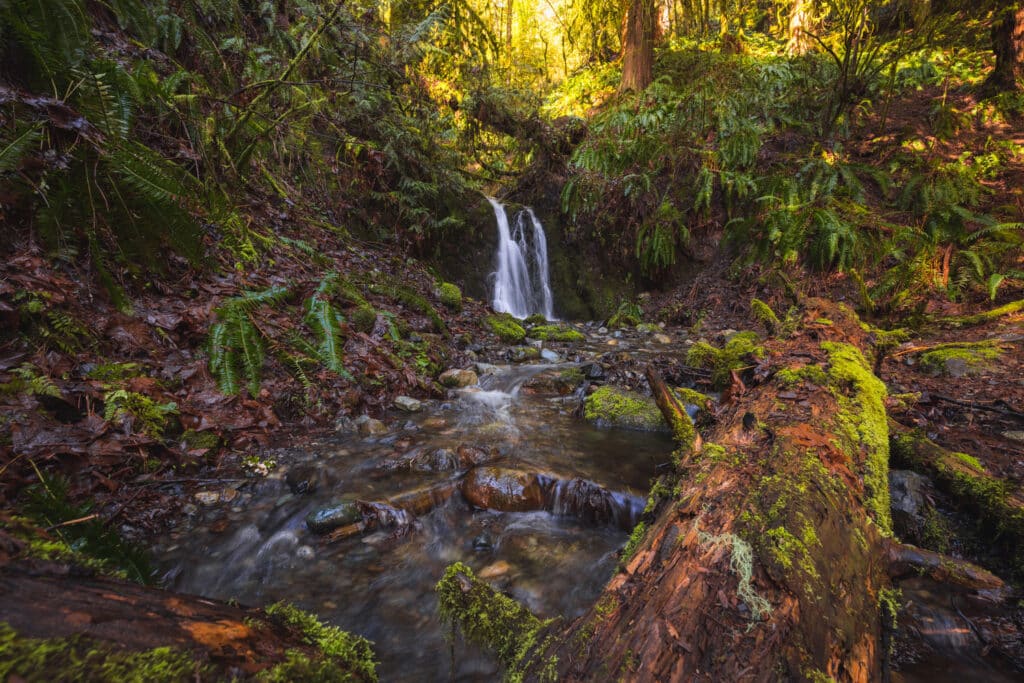
Durrance Falls
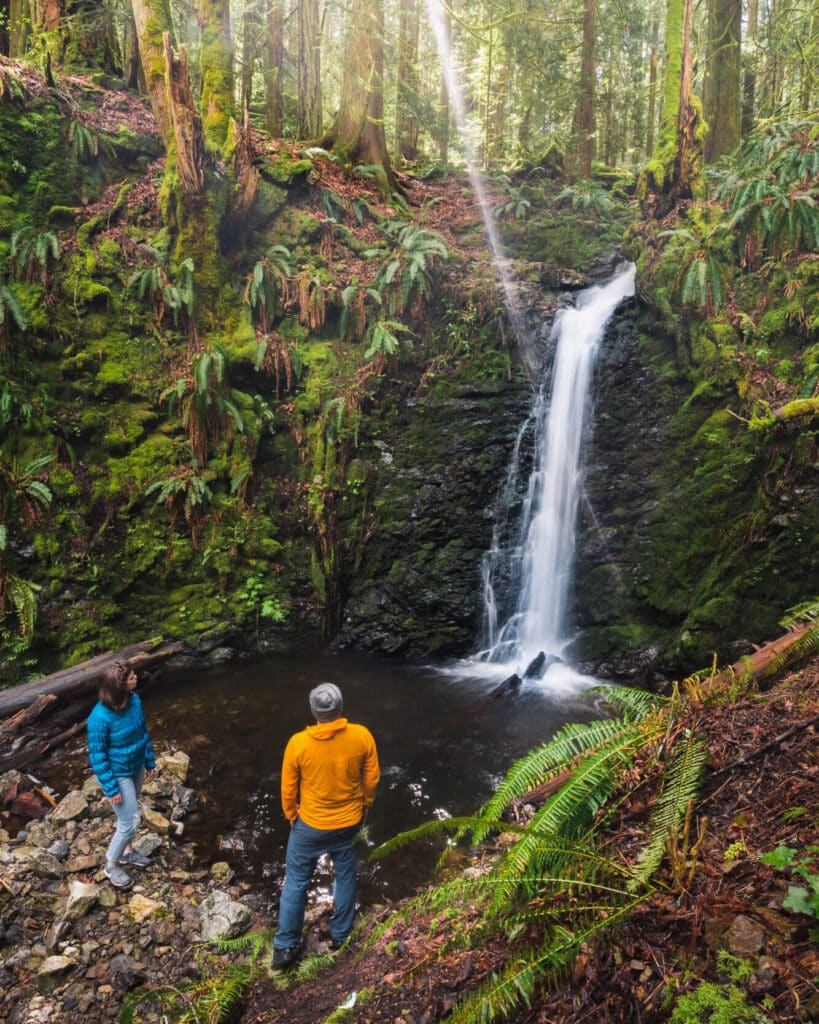
Distance from Downtown Victoria: 20 km
Walking Time: 20 mins
Durrance Falls was the first waterfall I visited on Vancouver Island, and the first post ever published on this blog. A short walk along level path leads around Durrance Lake, a popular fishing and swimming spot in the summer not far from Victoria. Great views of the waterfall from above are easily obtained, though an optional challenging downclimb to the base of the waterfall is possible.
Cascade Falls
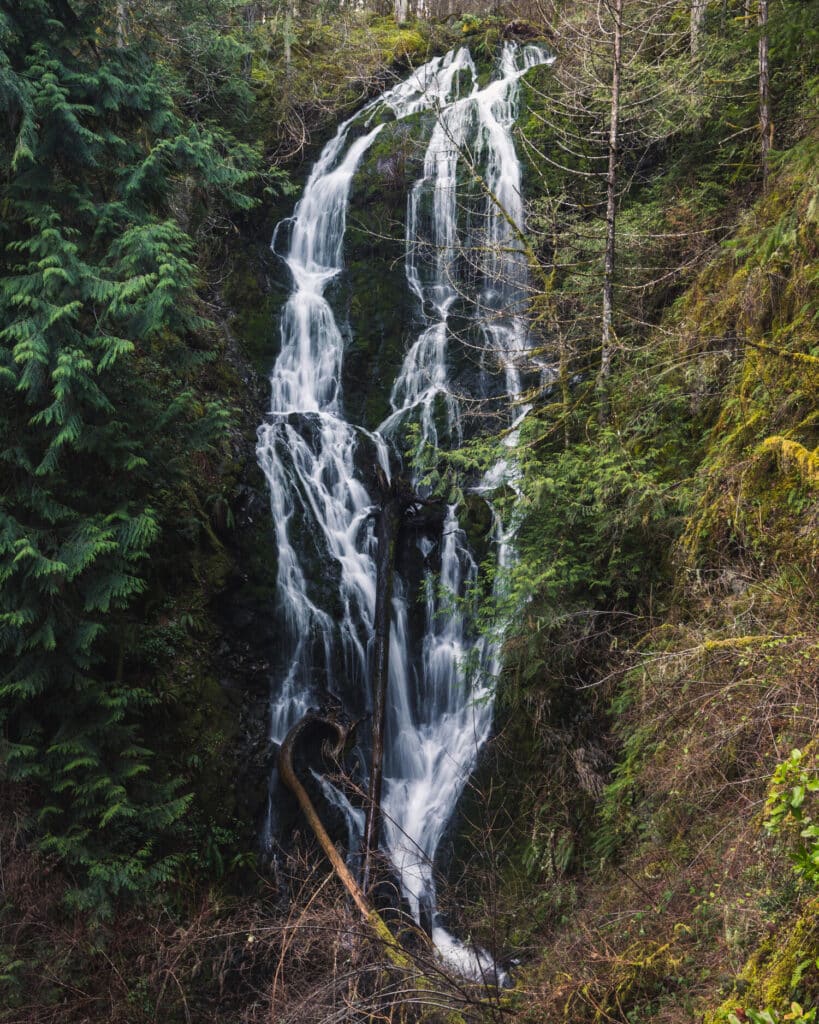
Distance from Downtown Victoria: 19 km
Walking Time: 40 mins
Cascade Falls in Gowlland Todd Provincial Park is located remarkably close to Durrance Falls and is a common stop along the walk to Mckenzie Bight, and is one of the tallest and most impressive waterfalls close to Victoria. The trail there does involve some steep stairs down to the fall, and it’s not really possible to approach the falls themselves due to the steep gully. Still, Cascade Falls is a must-visit waterfall near Victoria.
Recommended Hiking Gear



Water is a must whenever I’m hiking, especially if the sun is going to be out. My favourite water filter I’ve used is the Katadyn BeFree 0.6L, which unlike other water filters I’ve used packs up really small and lightweight. For hikes where I know there won’t be any readily available water sources along the way, I make sure to bring my own. The Hydrapak Stow 1L bottle is my go-to, for the same reason that it’s made of a soft plastic that folds up and doesn’t take up any more extra space than necessary in my pack. Finally, Aquatabs are another great option for purifying water, with one tablet being suitable for one litre of water. I previously used the Grayl water filter while travelling internationally, and though I found its hard body more convenient for day to day use and easier to drink from, it has a little too much bulk for my fast-and-light style of hiking.



The secret to all my photos of gorgeous sunset and sunrise mountaintop views? A lot of hiking in the dark. And let me speak from personal experience when I say that the last thing that you want to happen when hiking is to be caught in the dark without a headlamp. I used the Black Diamond Spot 400 for years and it worked great – until I lost it on top of a mountain somewhere. The only downside to it was having to worry about the batteries dying, though there’s also a slightly more expensive version that has a rechargeable battery. Nowadays I’m using the Petzl Actik Core, which is a bit pricier than the more budget-friendly Black Diamond, but is also brighter, more comfortable (in my opinion), and has a hybrid power system that is rechargeable but can also take AAA batteries if needed.
You won’t see me using trekking poles on shorter hikes often – but on long hikes and backpacking trips, as well as certain scrambles, they are an absolute lifesaver. I’ve invested in a high quality ultra-lightweight pair of MSR DynaLock Ascent carbon poles which, while pricey, I don’t regret one bit. If you’re not entirely sure how much use you’re going to get out of a pair of trekking poles, the best budget-friendly option would be the Trekology Trek Z 2.0. Amazon does sell a lot of cheaper Made in China-style trekking poles for cheaper, but these usually are much much heavier and not worth buying.
All the best and most long-lasting cables and power banks I’ve ever owned have been Anker. I once had a phone cable from them that lasted me over three years of daily use! That’s why I keep an Anker PowerCore Essential 20K power bank on me. Like many people I use my phone for a lot of stuff when hiking (checking in with family, using online maps, taking photos, flying my drone) so I like to be prepared for that low battery warning by having a backup power source on me just in case.



The only socks I ever buy for myself are from Darn Tough, and I almost always make sure to wear them when hiking. After years of having no problems only wearing these comfortable and rugged socks for hikes, I accidentally wore a pair of no-name socks on a hike last year and ended up with blisters on both feet. Safe to say I’m back to sticking with the Darn Tough. And the best part? They have a lifetime guarantee, meaning that if they ever wear out you can send them back for a brand new pair. For hiking footwear I go between a pair of lightweight approach shoes for quick and dirty mountain ascents or anything involving scrambling and more heavy-duty boots for longer treks. I’ve worn a couple different versions of the lightweight but super durable Arc’teryx Konseal FL 2 approach shoes for a few years now and am very impressed with the durability. I also really like the thick toecap that keeps me protected every time I stumble into a root or large rock. For longer, tougher, or muddier treks I rely on my LOWA Camino EVO GTX, which I find insanely comfortable and made of very high quality.



I wear my Ar’teryx Gamma Lightweight Pants on every single hike I go on, and on many days when I’m not hiking. After several years of abuse they are still holding together extraordinarily well, with only a few small holes from where I’ve fallen down and some slight stains from being repeatedly coated with mud. They’re lightweight, breathable, and super comfortable. For lightweight and breathable hiking tops I’m a big fan of both the Patagonia Capilene Shirt and the MEC Core Shirt. My Arc’teryx Squamish Hoody shows up in a lot of my photos. It’s super lightweight and packable, and does a great job of cutting the wind while also being pretty breathable. I also have an Arc’teryx Atom Hoody and Arc’teryx Beta LT that I pull out for cooler or wetter conditions.
